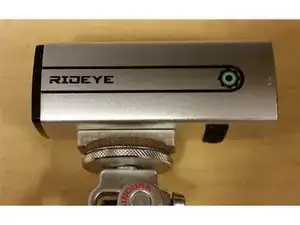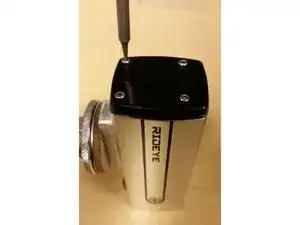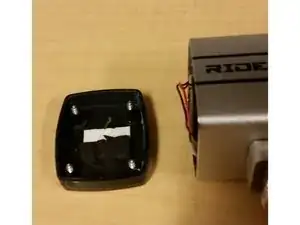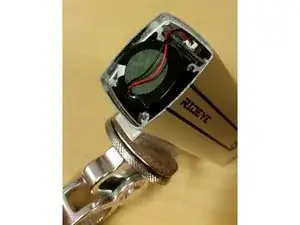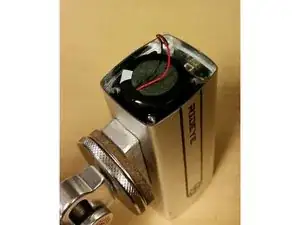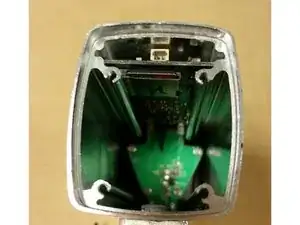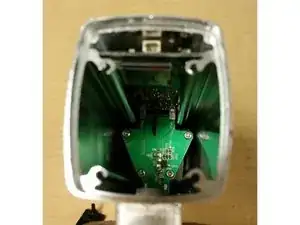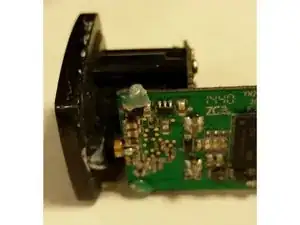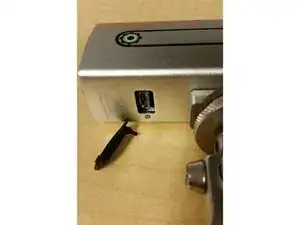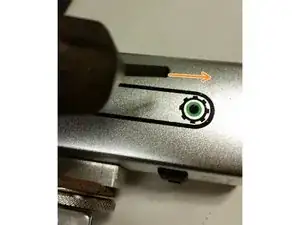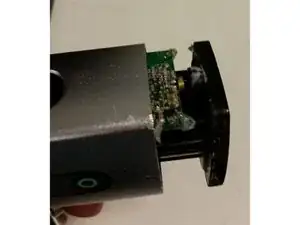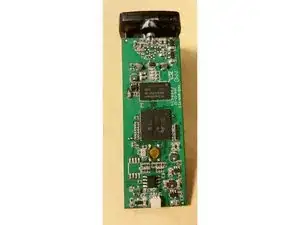Einleitung
I'll skip the overview of the Rideye here and hope a product page is actually made. Until then, check out the manufacturer's web page at http://www.rideye.com/
According to the Amazon reviews, the Rideye camera has had some failures.
I have an original Kickstarter sponsored camera and it too had failed. Though the failure modes probably are not all the same, this will allow you to get access to the main board to do some basic troubleshooting.
Werkzeuge
-
-
This is a basic Rideye camera. I have my own custom mount attached to it, but it is not necessary to remove the mount from the camera for this repair.
-
-
-
You now have access to the battery and microSD card.
-
If you want, you can replace the microSD card with a different capacity. You can also take out the existing microSD card, put it into a reader and plug it into your computer. This can help you check the footage and see when the camera stopped functioning, though not necessarily why.
-
Unplug and remove the battery, always being careful not to pull directly on the wires (even though we all do it).
-
Unfortunately, the contacts on the connector are really small, so measuring the voltage on the battery is difficult.
-
-
-
Down at the bottom of the battery compartment are four screws. You do not need to remove them.
-
-
-
How are the main board, the lens, and the surrounding trim held in so the battery doesn't push them out? Yeah, glue.
-
The main board is held in its slot by hot glue near the front corners (sorry, I had already removed it before taking photos).
-
From the white crazing of the plastic and the rough texture of its surface- it looks like the lens surround had some cyanoacrylate (superglue) on it.
-
-
-
You need to remove the top button in order to slide the main board out. It is simply peeled off.
-
While we're at it, remove the charging port cover so it doesn't get any heat damage. This too is carefully pulled out.
-
-
-
Yeah, "insides." Really technical term.
-
To remove the internal module of main board, USB connector board, lens, and lens surround (now you know why I just called it "insides."), you will need to loosen the cyanoacrylate and the hot glue.
-
Luckily, the cyanoacrylate doesn't bond well to the aluminum shell, so a firm hit on the lens surround should probably loosen it up. My camera had already experienced a fall, so I assume it had loosened then, not to mention I really took it apart another, less optimal way.
-
Loosening the hot glue is simply a matter of heating it up again. Heat the upper front sides of the shell with whatever heat source you have. I used a small butane torch, but you can probably use a hot air gun even though it diesn't have as fine of control, or a hot air soldering machine (pictured).
-
While heating the outside of the shell, push on the main board from the back until you feel it slip, and push everything out the front.
-
Needless to say, be careful not to melt the lens surround. If you've got it that hot, the hot glue melted long ago.
-
If you think you've melted the hot glue but the main board is still not budging, press (or hit) the lens surround back in towards the center of the camera to try to jar the cyanoacrylate loose, being careful about the hot aluminum.
-
-
-
Look at the main board. Does anything look wrong or discolored? Maybe there's a problem there. In my case, there was corrosion from water damage in various places. But what was really damaged?
-
Even though the battery voltage measured a reasonable 3.6 volts, it was dead. Temporarily wiring in a fully charged battery (you do have spare lithium ion batteries around, don't you?) revealed one particularly hot component. Yes, be careful when touching components on the main board, and look and smell for telltale signs of smoke or overheating.
-
Once you figure which component may be bad, remove and replace it. If you don't have any replacement, still remove it and test just to see how well it can limp by without it.
-
In my case, I removed one component, but it was actually an adjacent capacitor that was getting really hot. Removing that capacitor brought some functionality back- the LEDs actually lit. Replacing the original component and putting in a new capacitor brought everything back again.
-
-
-
To reinstall the main board, apply hot glue to the front corners of the main board. If you try to apply glue to the inside of the shell, the glue will be pressed in along the tracks and harden up before you can push the main board all the way in.
-
If you do it quickly enough, you can apply the hot glue and insert the main board before the hot glue hardens up. Otherwise heat up the shell again to soften the hot glue.
-
Optionally, you can apply either hot glue, or silicone caulk or cement to the inside edges of the lens surround. Silicone is easier since it will not set while you're pressing it in. With hot glue you will need to heat the whole front part of the shell.
-
You may also use cyanoacrylate on the lens surround since it's more easily available, but it is less waterproof and less flexible.
-
This still does not waterproof the front assembly- the lens is only friction fit into the lens surround. It may or may not be waterproof, and waterproofing the camera is beyond the scope of this guide.
-
The purpose of gluing in the lens surround is to cut down on the torque the USB connector board experiences as the battery presses on it from the back.
-
As usual, reassembly is the reverse of assembly, in fact, because I had already disassembled the camera in a less than optimal fashion, all these photos are of the reassembly, just in reverse order.
5 Kommentare
Edit: I continued reading and you do mention the SD card. Time to take mine apart and change to the larger storage.
Just curious, is there a memory chip inside or a SD card? Do both cameras come with the same memory and is it software that enables the larger memory? I have a camera with 8GB memory and I want to hack it to the 32GB memory.
Thoughts...
I have a 32 GB version and am thinking the battery is getting old. If I have it open I may look at if a larger amount of storage is possible. Have you tried changing the SD card to anything bigger than 32GB ?
jlindner -
owner website is dead, so it’s now officially EOL.
asquelt -
